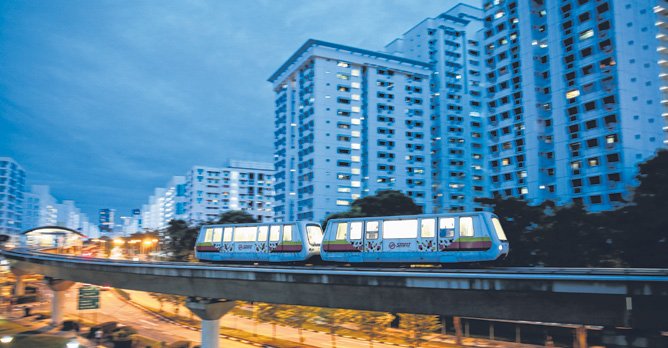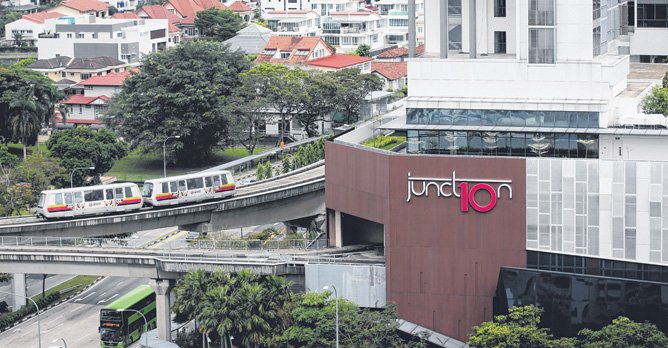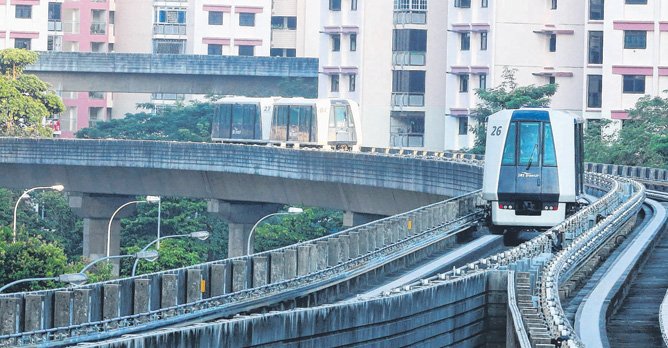Bukit Panjang LRT to leave problematic past behind
04 Dec 2019|1,859 views
The problematic Bukit Panjang LRT (BPLRT) should be able to match the Sengkang-Punggol LRT (SPLRT) in reliability by 2024, Transport Minister Khaw Boon Wan indicated yesterday.
Currently, the 20-year old BPLRT, operated by SMRT, clocks 64,000 car-km between delays, which Mr. Khaw described as "not bad, but could be much better". This is up from 33,000 car-km in 2015.
Noting that the 16-year old SPLRT, operated by SBS Transit, clocks more than 300,000 car-km between delays, the minister said that when the BPLRT's upgrading works are completed by 2024, it "should be able to close the gap" with the SPLRT.
The BPLRT started running in 1999 as Singapore's first LRT line and the first driverless system here. It connects commuters in Bukit Panjang to the Choa Chu Kang MRT station on the North South Line. "Residents looked to the BPLRT with great expectations," Mr. Khaw, who is also Coordinating Minister for Infrastructure, recalled during a visit yesterday to the BPLRT's depot.
But they were soon disappointed, as the system's reliability proved patchy from the start. Over the years, there were disruptions caused by numerous mechanical, electrical and operator issues. Some resulted in serious incidents such as a collision, fire, a train skipping stations and not responding to the emergency stop button, a train wheel falling off, and staff fatality.

"The local MPs were not too convinced," he said. "When I returned to the Ministry of Transport in 2015, I was determined to address the BPLRT problem decisively." Canadian engineering firm Bombardier, which supplied the original system in 1999, was awarded a $344 million contract last year to overhaul it.
Work is under way to replace trains, the signalling system and power rails, as well as to equip the BPLRT with a condition monitoring system, which is able to constantly check the well-being of the line. This will allow the operator to move from preventive and corrective to predictive maintenance.
When all the upgrading works are done by 2024, "residents can look forward to BPLRT version 2.0 with greater confidence this time", Mr. Khaw said. 19 of the oldest trains will be replaced with sleek tram-like trains equipped with some of the newest features, including better air-conditioning systems and eco-friendly LED lighting, while 13 newer trains will be retrofitted. This means the line will operate with two visually different trains.

This means it will still require a five-piece current collector assembly - which draws power from the power-supplying rail. But this time, the signalling contact will be delinked from this assembly to make the system more robust.
Many of the disruptions were caused by dislodged collector shoes. SMRT said it has already devised a jig to prevent collector shoes on current trains from dislodging. Since the jig was installed this January, there has been no shoe dislodgement cases.
The problematic Bukit Panjang LRT (BPLRT) should be able to match the Sengkang-Punggol LRT (SPLRT) in reliability by 2024, Transport Minister Khaw Boon Wan indicated yesterday.
Currently, the 20-year old BPLRT, operated by SMRT, clocks 64,000 car-km between delays, which Mr. Khaw described as "not bad, but could be much better". This is up from 33,000 car-km in 2015.
Noting that the 16-year old SPLRT, operated by SBS Transit, clocks more than 300,000 car-km between delays, the minister said that when the BPLRT's upgrading works are completed by 2024, it "should be able to close the gap" with the SPLRT.
The BPLRT started running in 1999 as Singapore's first LRT line and the first driverless system here. It connects commuters in Bukit Panjang to the Choa Chu Kang MRT station on the North South Line. "Residents looked to the BPLRT with great expectations," Mr. Khaw, who is also Coordinating Minister for Infrastructure, recalled during a visit yesterday to the BPLRT's depot.
But they were soon disappointed, as the system's reliability proved patchy from the start. Over the years, there were disruptions caused by numerous mechanical, electrical and operator issues. Some resulted in serious incidents such as a collision, fire, a train skipping stations and not responding to the emergency stop button, a train wheel falling off, and staff fatality.

"The local MPs were not too convinced," he said. "When I returned to the Ministry of Transport in 2015, I was determined to address the BPLRT problem decisively." Canadian engineering firm Bombardier, which supplied the original system in 1999, was awarded a $344 million contract last year to overhaul it.
Work is under way to replace trains, the signalling system and power rails, as well as to equip the BPLRT with a condition monitoring system, which is able to constantly check the well-being of the line. This will allow the operator to move from preventive and corrective to predictive maintenance.
When all the upgrading works are done by 2024, "residents can look forward to BPLRT version 2.0 with greater confidence this time", Mr. Khaw said. 19 of the oldest trains will be replaced with sleek tram-like trains equipped with some of the newest features, including better air-conditioning systems and eco-friendly LED lighting, while 13 newer trains will be retrofitted. This means the line will operate with two visually different trains.

This means it will still require a five-piece current collector assembly - which draws power from the power-supplying rail. But this time, the signalling contact will be delinked from this assembly to make the system more robust.
Many of the disruptions were caused by dislodged collector shoes. SMRT said it has already devised a jig to prevent collector shoes on current trains from dislodging. Since the jig was installed this January, there has been no shoe dislodgement cases.
Latest COE Prices
July 2025 | 2nd BIDDING
NEXT TENDER: 06 Aug 2025
CAT A$101,102
CAT B$119,101
CAT C$68,600
CAT E$120,000
View Full Results Thank You For Your Subscription.





















